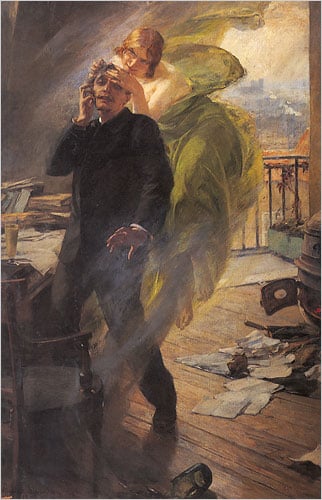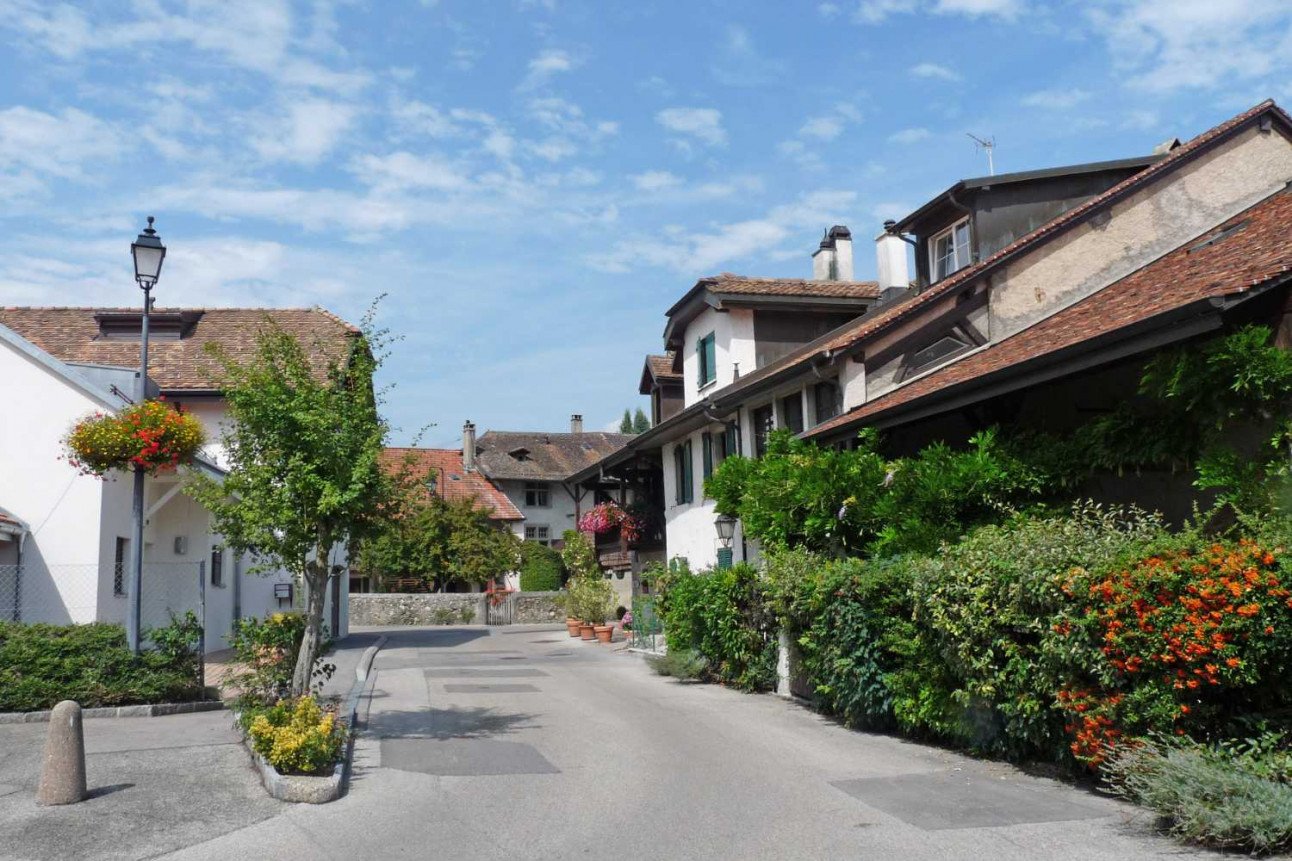Whether it be where the drink was created in the Swiss canton of Neuchâtel or as far away as the United States, absinth has a reputation.
Psychoactivity, hallucination and debauchery are all associated with the (sometimes) green drink, attributed to a special chemical property in the spirit which goes beyond its high alcohol content.
But while claims of absinth having a hallucinogenic property have been largely disproven, few know that the origin of the worldwide ban on the spirit came out of a winegrower’s drunken rampage in the small Swiss village of Commugny.
What followed was mass hysteria, based on a twisting of the original events – and a century-long ban that only began to thaw in the early 2000s.

Albert Maignan’s Green Muse (1895) depicting a poet succumbing to the absinth fairy. Image: Wikicommons.
Commugny
The village of Commugny in the Nyon district of Vaud is as idyllic and quaint as one would expect of a Swiss village.
READ: Switzerland’s ten most beautiful villages you have to visit
Located just near the French border, Commugny is a microcosm of modern Switzerland.
With a population of 3,000 – roughly ten times that of 1950 – more than a third are foreign nationals.
Two thirds (66.5 percent) speak French, while 17 percent speak English. German (eight percent) and Italian (one percent) round out the town’s linguistic diversity, while according to government information from 2014, one resident speaks the fourth Swiss national language: Romansh.
Other than being the site of a heinous series of murders which led to a worldwide ban on absinth, the town’s only other claim to fame is George de Mestral – the inventor of velcro. De Mestral lived and died in Commugny and L’avenue George de Mestral is named in his honour.

The village of Commugny. Image: Wikicommons.
The murders
On August 28th, 1905, Swiss winegrower Jean Lanfray sat down to eat lunch.
According to the ever-reliable Wikipedia – which cites a link on absinth history which appears to be broken – Lanfray drank “seven glasses of wine, six glasses of cognac, one coffee laced with brandy, two crème de menthes, and two glasses of absinthe after eating a sandwich”.
Whether Wiki is right on the exact makeup of Lanfray’s final tab is uncertain, but Swiss newspaper Le Temps and historical storytellers Atlas Obscura agree that whatever he drank, there was a lot of it – the latter says he drank several litres of wine.
And they all agree that he definitely drank some absinth.
After leaving the lunch, Lanfray went home with his father and got into an argument with his pregnant wife before the father left.
Details are expectedly sketchy and incomplete, but not long after returning home, he had murdered his wife and their two daughters – aged four and one – before unsuccessfully attempting to kill himself.
Police were tipped off by the man’s father, who found Lanfray collapsed in the backyard, where he had been attempting to carry the body of his youngest daughter.
After recovering in a hospital, Lanfray was found guilty. He avoided capital punishment due to diminished responsibility because of the alcohol consumption, but was sentenced to 30 years imprisonment as a result of the crime.
Three days after the trial, Lanfray died, he was found hanging in his prison cell.

The aftermath
The case received a significant amount of coverage, which was at least in part due to the temperance movements on both sides of the Atlantic. They saw the case as a great way to push their alcohol ban agenda.
Absinth became a great scapegoat for a perceived lack of morality in society at the time – particularly with regard to drinking.
A prominent French critic wrote in a temperance petition that absinth was to be blamed for everything from criminality to tuberculosis.
“Absinthe makes you crazy and criminal, provokes epilepsy and tuberculosis, and has killed thousands of French people. It makes a ferocious beast of man, a martyr of woman, and a degenerate of the infant, it disorganises and ruins the family and menaces the future of the country.
According to the book Absinthe: History in a Bottle, prominent Swiss psychologist Dr. Albert Mahaim testified at the trial that Lanfray was suffering from “a classic case of absinthe madness”, apparently ignoring all of the other alcohol (and an apparent lack of food) in his system.
From there, a worldwide domino effect came into play – with Switzerland in 1907 starting a process which would see a ban on absinthe inserted into the constitution.
The ripple effect saw absinthe banned in every European country except Spain, Sweden and the United Kingdom. Even where it wasn’t banned, it fell out of favour – particularly in Spain where it had previously been popular.
In the US, where moves towards prohibition were gaining traction, the ban on absinth came at a perfect moment.
Absinth production and importation was banned in the US in 1912, just eight years before the constitutional amendment on prohibition.

Sugar burns on an absinth spoon. Image: Wikicommons.
Modern day
It was not until the turn of the millennium when absinth started to make its way back to mainstream consumption in Europe and the United States.
In Switzerland, absinth was again legalised in 2005 – exactly a century after the murders which led to its ban.
A major factor in its resurgence was due to a better understanding of what it was – and what it wasn’t.
Studies showed evidence that no part of the drink – not wormwood or thujone – brought about the drink’s apparent stimulant effects, primarily due to the low quantity present.
The real culprit – both in the Lanfray killings and in absinth in general – is likely to have been hiding in plain sight all along: alcohol, and lots of it.




 Please whitelist us to continue reading.
Please whitelist us to continue reading.
Member comments